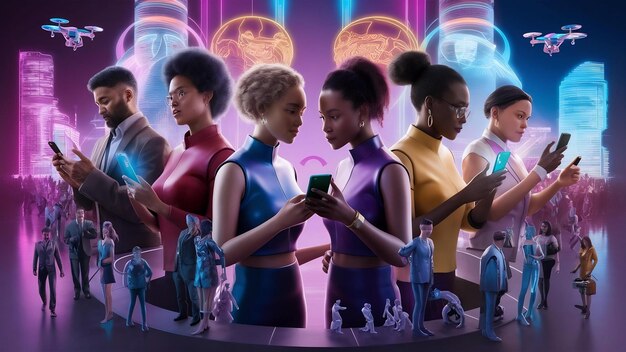Gen Z’s Impact: 4 Trends Shaping the Metaverse Future

Gen Z’s intuitive engagement with digital realms is profoundly influencing the metaverse, driving innovation through their demand for authentic social interaction, user-generated content, unique digital identities, and new economic models within virtual environments.
The metaverse, once a subject of science fiction, is rapidly becoming a tangible digital frontier, and at its heart lies a powerful demographic: Gen Z. Born into a world steeped in digital interactivity, this generation isn’t merely observing the metaverse; they are actively shaping its evolution, dictating its norms, and defining its future. Their unique digital fluency and social dynamics are carving out new paradigms within virtual worlds, prompting businesses and developers to rethink engagement strategies.
gen Z’s native digital fluency: the foundation
Gen Z, often dubbed ‘digital natives,’ has an inherent understanding of virtual spaces that sets them apart from previous generations. Their formative years have been characterized by constant exposure to online communities, gaming platforms, and social media, making the leap into immersive virtual worlds a natural progression rather than a radical change. This innate comfort with digital interactions serves as the bedrock for their profound influence on the metaverse’s development. It’s not just about consuming content; it’s about active participation, creation, and belonging within these evolving digital ecosystems.
Their fluency stems from a lifelong experience of navigating complex digital environments. From intricate multiplayer online games to highly personalized social media feeds, Gen Z has consistently leveraged technology for connection, self-expression, and entertainment. This continuous engagement has cultivated a sophisticated level of digital literacy, allowing them to intuitively grasp the nuances of virtual economies, avatar customization, and collaborative online spaces. Consequently, when presented with the nascent metaverse, they don’t approach it as a mere tool but as an extension of their lived experience, an arena ripe for innovation and personal impact.
the power of early adoption and digital literacy
Gen Z’s digital savviness isn’t just about quick adaptation; it’s about an expectation of seamless, intuitive digital experiences. They grew up expecting instant connectivity and personalized content, translating this expectation directly into their interactions with the metaverse.
- Intuitive navigation: They quickly master new platforms and interfaces.
- Experimentation: Not afraid to try new features and push boundaries.
- Demand for seamlessness: Expect frictionless transitions and high performance.
This generation’s comfort with digital experimentation and their readiness to adopt new technologies early on are significant drivers for metaverse platforms. They are the first to explore new features, provide feedback, and implicitly guide developers towards more engaging and user-centric designs. Their collective usage patterns and preferences are invaluable data points for companies looking to build sustainable virtual economies and communities.
a shift from passive consumption to active creation
Unlike earlier generations who primarily consumed digital content, Gen Z is defined by its strong inclination towards creation. Think of TikTok or YouTube – these platforms thrive because users are not just viewers but content creators. This ethos translates directly to the metaverse, where they seek tools and opportunities to build, customize, and contribute.
Their natural inclination towards content creation means they are not just users but active participants in shaping the metaverse’s landscape. They are less interested in passively consuming ready-made experiences and more attracted to platforms that offer tools for building, customizing, and expressing themselves visually. This demand for creative liberty is forcing platforms to evolve, providing robust toolkits for user-generated content (UGC), from avatar customization to building elaborate virtual spaces. It’s a clear signal that the metaverse will be less about top-down design and more about bottom-up ingenuity.
Gen Z’s comfort with self-expression and identity exploration online is another crucial factor. They utilize avatars not just as representations but as alternate selves, experimenting with personas and challenging real-world limitations. This fluid approach to identity encourages a more diverse and inclusive virtual environment compared to traditional social media, fostering spaces where authenticity and creativity can flourish without many of the constraints found offline.
trend 1: authentic social interaction is paramount
For Gen Z, the metaverse isn’t primarily about commerce or flashy graphics; it’s fundamentally about connection. They seek out virtual environments that facilitate authentic, spontaneous, and meaningful social interactions, mirroring and often enhancing their real-world relationships. This goes beyond simple messaging or voice chat; it encompasses shared experiences, collaborative activities, and the ability to truly ‘be’ with friends in a digital space. The platforms that succeed in capturing Gen Z’s loyalty will be those that prioritize robust social features and foster a genuine sense of community.
The pandemic-induced shift to remote interactions further solidified Gen Z’s reliance on digital platforms for social connection. They experienced firsthand how virtual spaces could bridge physical distances, facilitating everything from online gaming nights to virtual study groups. This experience has instilled a high expectation for the quality and intimacy of metaverse social features. They look for environments where they can hang out, play games, attend virtual concerts, or even just exist alongside their friends, creating shared memories in persistent digital worlds.
beyond passive consumption: shared experiences
Gen Z views the metaverse as a place for active participation. They are less interested in simply viewing content and more keen on co-creating experiences with friends. This manifests in virtual events, collaborative games, and persistent hangouts.
Authenticity in these interactions is key. They value real-time presence, nuanced communication, and the feeling of shared space. This pushes metaverse developers to innovate beyond simple chat functionalities, integrating more expressive avatar movements, spatial audio, and interactive environments that allow for rich, dynamic social engagement.
the rise of ‘hangout’ culture
The concept of ‘hanging out’ virtually is central to Gen Z’s social dynamic within the metaverse. These aren’t necessarily structured events but rather spontaneous gatherings where friends can simply exist together in a shared digital space, talking, playing, or exploring. This casual, low-pressure environment fosters genuine connection.
Platforms that offer customizable private spaces, casual mini-games, and easy ways to invite friends will thrive. Think of the appeal of a virtual living room where friends can drop in and out freely, rather than a scheduled meeting room. This emphasis on organic social engagement differentiates Gen Z’s approach from earlier generations’ use of the internet for purely transactional or informational purposes.

trend 2: user-generated content (ugc) as the new frontier
Gen Z isn’t just consuming the metaverse; they are actively building it. Their inherent desire for self-expression and creativity finds a perfect outlet in platforms that empower them to create their own content, whether it’s designing custom avatars, building virtual homes, or developing entire games within the metaverse. This focus on user-generated content (UGC) is transforming the metaverse from a top-down creation to a dynamic, community-driven ecosystem. The platforms that provide robust, intuitive tools for creation will undoubtedly attract and retain this highly creative demographic.
This trend is a natural extension of their engagement with platforms like TikTok, Roblox, and Minecraft, where creating and sharing content is a fundamental aspect of the user experience. They bring a ‘maker’ mentality to the metaverse, viewing it as an expansive canvas for their imaginations. This isn’t just about personal projects; it’s also about building communities around shared creative endeavors and even monetizing their digital creations. The democratizing power of UGC ensures that the metaverse remains diverse, innovative, and reflective of its users’ collective vision.
empowering the creator economy
The metaverse offers unprecedented opportunities for Gen Z creators to monetize their skills and passions. From designing virtual fashion items to building entire virtual experiences, the potential to earn revenue from UGC is a significant draw.
- Digital fashion and accessories: Creating unique attire for avatars.
- Virtual real estate and architecture: Designing and selling digital spaces.
- Game development: Building mini-games and experiences within platforms.
This emergence of a creator economy within the metaverse is a powerful incentive. It aligns with Gen Z’s entrepreneurial spirit and their desire for multiple income streams. Platforms that offer clear pathways for monetization, fair revenue sharing, and robust intellectual property protection will empower a new generation of digital entrepreneurs. Companies like Roblox have already demonstrated the success of this model, where young creators can earn significant income from their in-game creations.
the democratized creative process
The beauty of UGC in the metaverse lies in its accessibility. Unlike traditional game development or content creation, metaverse platforms often provide simplified tools that allow users with varying skill levels to contribute. This democratized creative process fosters a diverse range of content and ensures that innovation isn’t limited to professional studios.
This approach encourages participation and lowers the barrier to entry for aspiring creators. It also means that the metaverse’s content is constantly refreshed and evolving, driven by the collective creativity of its users rather than a centralized development team. This iterative, community-driven development cycle is key to maintaining relevance for Gen Z, who thrive on novelty and constant innovation.
trend 3: fluid and evolving digital identities
Gen Z views their digital identities as fluid and adaptable, experimenting with different personas and forms of self-expression across various virtual platforms. The metaverse, with its emphasis on avatars, customization, and multi-world presence, provides an ideal canvas for this ongoing exploration. They aren’t tied to a singular, static identity but rather embrace the freedom to evolve, transform, and express different facets of themselves within virtual realms. This desire for dynamic identity representation influences how they interact with virtual goods, social spaces, and brand experiences.
This fluidity stems from growing up with highly curated online profiles and the ability to present different versions of themselves on various social media platforms. In the metaverse, this concept is taken to a new level through increasingly sophisticated avatar customization tools and the ability to seamlessly transition between different virtual environments. For Gen Z, an avatar isn’t just a picture; it’s a living, breathing extension of their identity, capable of expressing their mood, style, and aspirations in a way that physical limitations often prevent.
avatars as extensions of self (and aspiration)
Avatars are more than just digital representations; they are powerful tools for self-expression and identity exploration for Gen Z. They invest time and often money into customizing their avatars to reflect their current mood, ideal self, or even a fleeting trend.
The level of detail and personalization available for avatars directly correlates with Gen Z’s engagement. They look for platforms that offer:
* Extensive customization options: From facial features to clothing and accessories.
* Interoperability: The desire for avatars to move somewhat seamlessly between virtual worlds.
* Expression beyond the physical: The ability to embody fantastical or abstract forms.
This deep personal investment in avatars transforms the digital self from a mere profile into a fully immersive experience. It allows for a level of creativity and self-styling that transcends the limitations of the physical world, offering a new dimension for personal branding and social signaling within virtual communities.
the blurring lines between digital and physical fashion
The intersection of digital and physical fashion is particularly compelling for Gen Z. They see digital wearables for their avatars as just as valid a form of style expression as physical clothing. This creates new opportunities for brands to engage with this demographic through virtual fashion lines and NFT wearables.
This trend extends beyond mere aesthetics. Digital fashion can represent status, community affiliation, and personal taste in a persistent, shareable way within virtual realms. The unique appeal of owning a rare digital item or participating in an exclusive virtual fashion show resonates deeply with Gen Z’s digital-first mindset, further blurring the lines between their online and offline identities.
trend 4: blockchain, nfts, and new economic models
Gen Z is not just a consumer; they are increasingly becoming participants in and architects of new digital economies. Their skepticism towards traditional institutions and their early adoption of decentralized technologies make them prime candidates for embracing blockchain-based economic models within the metaverse. This includes their engagement with NFTs (non-fungible tokens) for digital ownership, their interest in cryptocurrency as a medium of exchange, and their exploration of play-to-earn gaming mechanisms. These technologies represent a fundamental shift from centralized control to user autonomy and ownership, a concept highly appealing to this generation.
This interest stems from their innate understanding of digital scarcity and the value of digital assets, primarily from their experiences within intricate in-game economies. They appreciate the transparency and immutability offered by blockchain, seeing it as a way to truly own their digital creations and assets rather than simply license them. This paves the way for new business models that empower users, from artists selling unique digital art to gamers earning tangible value from their in-game achievements.
digital ownership and scarcity through nfts
NFTs represent a paradigm shift in digital ownership, and Gen Z is at the forefront of this adoption. They understand the concept of digital scarcity and the value that unique, verifiable digital assets can hold. This includes digital art, collectibles, virtual real estate, and even in-game items.
The appeal of NFTs for Gen Z lies in:
* Verifiable ownership: A clear, immutable record of who owns a digital asset.
* Scarcity and value: The ability to create and trade limited-edition digital goods.
* Creator empowerment: Directly supporting artists and creators without intermediaries.
play-to-earn and the token economy
The “play-to-earn” model, where users can earn cryptocurrency or NFTs through gaming, resonates strongly with Gen Z. This blends their love for gaming with their desire for financial independence and new economic opportunities. It transforms time spent in virtual worlds from mere entertainment into a potential source of income.
This model is a powerful motivator, attracting a new wave of users who are not just playing for fun but also for tangible economic benefits. It shifts the power dynamic, allowing users to earn value from their contributions and participation within the metaverse, rather than just being consumers. The integration of token economies means users can trade, sell, or even stake their digital assets, creating a dynamic and self-sustaining virtual marketplace.

decentralization and consumer control
Gen Z displays a general distrust of centralized authority and often prefers decentralized systems. Blockchain technology, by its very nature, offers a more transparent and user-controlled environment, which aligns well with this generational preference.
This includes:
* Data privacy: Greater control over their personal data.
* Platform transparency: Open protocols and decentralized governance.
* Community-driven development: A say in the future of the platforms they use.
The decentralization aspect of many metaverse projects appeals to Gen Z’s desire for autonomy and agency. They are more likely to gravitate towards platforms that offer transparent governance models, where users have a voice in decision-making and a stake in the platform’s success. This fosters a sense of collective ownership and makes them active stakeholders, not just passive users.
| Key Aspect | Impact on Metaverse |
|---|---|
| 🫂 Authentic Social Interaction | Drives demand for rich, spontaneous connection features. |
| 🛠️ User-Generated Content (UGC) | Fosters a vibrant creator economy and diverse content. |
| 🎭 Fluid Digital Identities | Promotes deep avatar customization and identity exploration. |
| 💰 New Economic Models | Accelerates adoption of NFTs, play-to-earn, and crypto. |
frequently asked questions
Gen Z’s extensive digital literacy and inherent comfort with online social interactions make them key early adopters and innovators in the metaverse. They are not merely users but active shapers, driving trends in social engagement, content creation, and digital identity, which are crucial for the metaverse’s long-term growth and evolution.
Gen Z prioritizes authentic, spontaneous social interactions, moving beyond basic communication to demand rich, shared experiences. They value “hangout” spaces and collaborative activities, pushing developers to integrate more immersive social tools, spatial audio, and interactive environments that foster genuine digital connections among users within virtual worlds.
UGC is central to Gen Z’s engagement, as they are creators, not just consumers. They seek platforms that offer robust tools for designing avatars, building virtual spaces, and developing games. This emphasis on UGC fuels the metaverse’s creator economy, allowing Gen Z to monetize their skills and contribute to a diverse, community-driven digital landscape.
Gen Z views digital identities as fluid and experimental, using avatars as extensions of self and tools for self-expression. They embrace the freedom to embody various personas and styles, leading to a high demand for extensive avatar customization and sparking interest in digital fashion and wearables as legitimate forms of style and status in virtual realms.
Their skepticism towards traditional systems and comfort with digital assets make Gen Z early adopters of blockchain technologies in the metaverse. They are drawn to NFTs for verifiable digital ownership and play-to-earn models for new economic opportunities, appreciating the transparency and user autonomy these decentralized systems offer for their digital creations and investments.
conclusion
As we peer into the future of virtual worlds, it becomes undeniably clear that Gen Z is not merely a cohort of users but the principal architects of the metaverse. Their unique blend of digital fluency, coupled with a deep-seated desire for authentic connection, creative expression, and tangible ownership, is actively shaping its form and function. The four key trends—authentic social interaction, the dominance of user-generated content, fluid digital identities, and the adoption of new economic models—are all direct reflections of this generation’s values and behaviors. Businesses and developers who fail to understand and adapt to these profound influences risk being left behind in a rapidly evolving digital landscape. The metaverse’s success will ultimately lie in its ability to empower Gen Z as both its primary inhabitants and its most influential creators, fostering a truly dynamic, user-driven virtual frontier.





